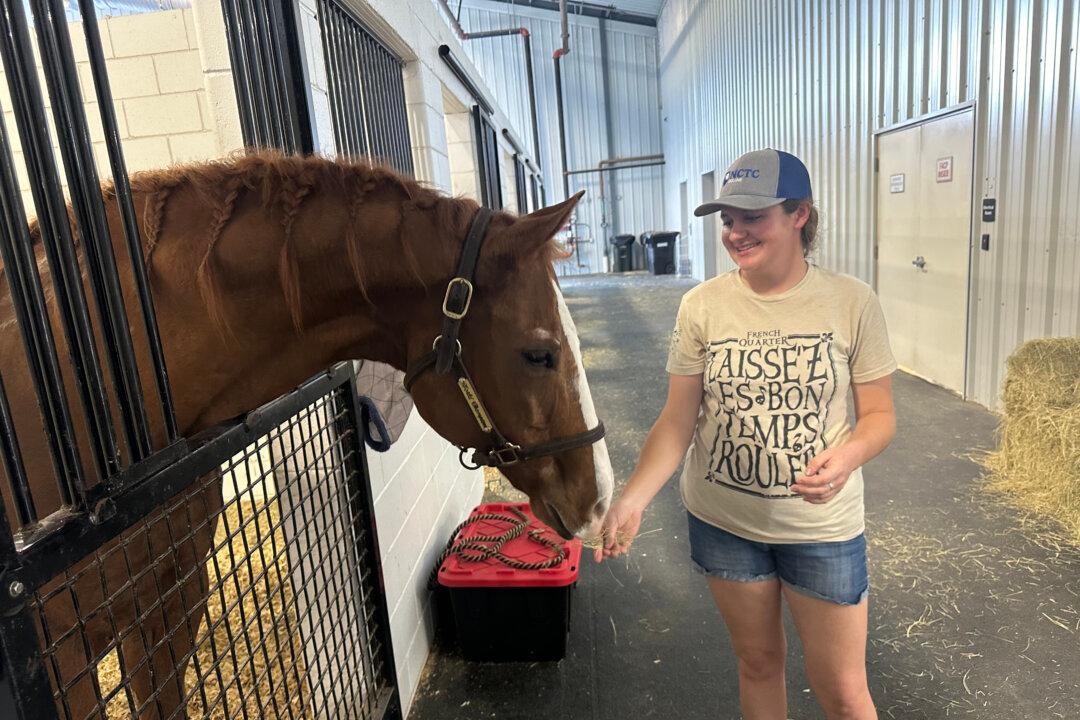NEWBERRY, Fla.—A pro-life group has announced it will try again to get a proposed state constitutional amendment—protecting all “human beings” with “a detectable heartbeat”—on ballots in Florida, this time aiming for the November 2024 election.
The group’s first attempt, which began officially in November 2019, failed meet the state’s requirements to put the amendment on the ballot this year.
The measure, signed April 14, bans most abortions in the state after 15 weeks of pregnancy. It’s set to go into effect on July 1.
Under the new Florida law, abortions still would be allowed to save a mother’s life, or to end a pregnancy in which the fetus has a fatal abnormality.
Penalties for performing or actively participating in the termination of a pregnancy not allowed under the new law would be a third-degree felony, punishable by up to five years in prison and fines of up to $5000.
Meanwhile, the legality of abortion throughout the country shifts daily.
Almost as soon as they’re enacted, most new state laws aimed at restricting the procedure face challenges in court that block them.
But not all pro-lifers cheered.
Some opposed to abortions argued the new law—passed by the Republican-led legislature and signed by the Republican governor—doesn’t go far enough.

“While the bill Gov. DeSantis signed is definitely progress in the right direction, there’s still much more to do in Florida to protect the pre-born,” Mark Minck, state chairman for Protect Human Life Florida, told The Epoch Times.
The group Minck leads will attempt—again—to collect 891,589 petitions signed by Florida voters by Feb. 1, 2024. If successful, that will earn their proposed Human Life Protection Amendment a spot on the ballot that November.
For it to pass, the amendment then would need the approval of 60 percent of people casting votes in the election. Because that election also will choose the U.S. president, turn-out is expected to be high.
“Historically high,” Minck predicts.
But ideally, his effort to collect petitions with a volunteer army won’t be needed, he says.
He hopes his state’s governor has signaled, in the words he’s used lately, that he plans to champion more restrictions on abortion in an upcoming session of the Florida Legislature.
DeSantis’ office had not responded to requests for comment by the time of publication.
“But we’re taking action, in the event we have to perform legislative-bypass surgery,” Minck chuckled.
Taking a more serious tone, he added, “I’m hopeful that this is the turning point pro-life Floridians have been praying for. I took particular notice that the governor continues to reference that ’these babies have beating hearts [when talking about abortion],' especially since this undeniable sign of life actually begins several months earlier in the gestational stage of pregnancy than the protections provided by” the new Florida law.
A human fetus has a heartbeat that can be detected by ultrasound at about six weeks. Florida’s new law would allow abortions for nine more weeks.

In 2018, there were 70,083 abortions reported in Florida. That number grew to 79,648 abortions last year. And only about 5 percent of abortions were performed past the 15-week cut-off established by the new law, Minck said.
So the new Florida law likely won’t cut the number of abortions in the state by much, he said.
“A bill that bans about 5 percent of the almost 80,000 abortions being performed in Florida is equivalent to progressing only five yards on a 100-yard field,” Minck said.
Indeed, across the country, about 91 percent of abortions are performed in the first 13 weeks of pregnancy, according to the Centers for Disease Control and Prevention (CDC).
Carrying out more abortions than any other provider in the United States is Planned Parenthood. And while most women have abortions early in the pregnancy, some women do seek abortions after 12 weeks, the organization states on an informational page on its website.
Women choose later abortions, the Planned Parenthood web page states, often due to “exposure to intimate partner violence, absence of partner due to estrangement or death, lack of financial or emotional support from partner, [being unaware of the pregnancy due to a] lack of pregnancy symptoms” and “psychological denial of pregnancy, as may occur in cases of rape or incest.”
Adolescents are more likely than older women to seek abortions later in pregnancy, Planned Parenthood educational materials state.
Among adolescents under 15, one in five abortions are performed after 13 weeks of gestation. And 12 percent of girls ages 15-19 hold off on having an abortion until after their 13th week of pregnancy. So abortions later in a pregnancy should not be restricted, the organization has argued.

“Common reasons why adolescents delay abortion until after the first trimester include fear of parents’ reaction, denial of pregnancy, and prolonged fantasies that having a baby will result in a stable relationship with their partners,” Planned Parenthood educational materials state.
In the materials, the organization calls those hoping to limit later-in-pregnancy abortions “anti-women’s health activists.” Yet, “the rate of complication increases 38 percent for each additional week of gestation beyond eight weeks” of pregnancy, the organization acknowledges.
Planned Parenthood did not respond to requests for comment.
Minck feels sure that the time is right to try to further limit abortions in Florida, a state that now has more registered Republicans than Democrats. But it’s not because it’s necessarily a partisan issue.
“This issue transcends party politics,” he said.
Florida accounts for about eight percent of the nation’s abortions, according to The Guttmacher Institute, a 54-year-old research and policy organization that fights for sexual and reproductive rights.

In 2017, the most recent year analyzed by the group, there were about 862,320 abortions performed in the United States.
California leads the nation in abortions, accounting for more than 15 percent; New York has the second-highest number with more than 12 percent, the institute reports.
The 2017 abortion rate was about 13.5 abortions per 1,000 women of reproductive age, down slightly from 2014, the institute reports.
Since 1973, when the U.S. Supreme Court recognized abortion as a constitutional right in the Roe v. Wade decision, states have added hundreds of restrictions on abortion.
In 2021, more than 100 new restrictions were enacted in states, more than in any year since the landmark case, the institute reports.

A new Texas law that went into effect Sept. 1 is one of those still in effect, despite legal wrangling. The law permits private parties to sue if an abortion is performed after the fetus has a detectable heartbeat unless a physician believes a medical emergency for the mother exists.
Kentucky’s new law prohibits abortion on a pregnant woman after the fetus reaches the probable gestational age of 15 weeks, except in the case of a medical emergency of the mother.
But days after being passed that law already is on shaky ground and faces legal challenges from Planned Parenthood and a clinic represented by the American Civil Liberties Union (ACLU).
Oklahoma Gov. Kevin Stitt (R) signed a law on April 12 banning abortions in his state and making it a felony to provide one. But legal challenges are expected, anti-abortion activists say.

A new law in Arizona, set to take effect in August, prohibits abortion beyond 15 weeks of pregnancy, except when it’s needed due to the mother’s medical emergency. That one also is likely to draw challenges, activists say.
Idaho passed a measure in 2021 that would take effect 30 days after any U.S. appellate court upholds a “heartbeat law.” It would prohibit an abortion following detection of a fetal heartbeat, except in the case of medical emergency, rape, or incest.
Activists on both sides of the abortion debate anxiously have been awaiting a U.S. Supreme Court decision that reportedly has been made, but not yet revealed, about the constitutionality of Mississippi’s new law banning abortions after 15 weeks of pregnancy.
Either way, Florida volunteers plan to plow ahead in their efforts.
For now, Minck’s team is working to complete the required process with the Florida Division of Elections to begin collecting petitions again. In trying to qualify for this year’s ballot, the Human Life Protection Amendment effort was one of 31 citizen-led petition initiatives. None of those efforts to allow voters to decide on proposed constitutional amendments—ranging from banning hunts of captive wildlife to legalizing marijuana cultivation—succeeded.
While further limiting abortions is part of what Protect Human Life Florida hopes to accomplish, the group’s proposed amendment is about more than just prohibiting the termination of most pregnancies after a fetal heartbeat can be detected.
“This is designed to protect all human life throughout the spectrum of life,” Minck said. “So this is not just about protection for the pre-born, but other vulnerable human lives, as well—the elderly, the infirm, and the disabled.”
The proposed amendment would add this language to the Florida Constitution: “all human beings have a right to life regardless of age, illness, or disability when there is a detectable heartbeat.”
It would not impede medical management of an ectopic pregnancy, which can be dangerous for a pregnant woman. And it would not seek to restrict law enforcement operations, bring an end to the death penalty for capital offenses, or interfere with end-of-life decision-making, such as the use of a living will or do-not-resuscitate order, Minck said.

The amendment language would require Florida lawmakers to enact legislation to implement the measure within 12 months of passage.
Only if enough validated petitions are collected will Florida voters will have the opportunity to approve or reject the proposed amendment. As of March 31, the state of 22 million residents had 14,308,327 registered voters, according to the state’s Division of Elections.
“The bar is high, and the process difficult,“ Minck said. ”But every Florida voter who signs the petition is speaking on behalf of the those who cannot speak for themselves.”





